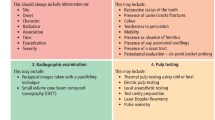Abstract
Data sources PubMed, Scopus and Web of Science.
Study selection Cohort (retrospective and prospective) and cross-sectional clinical studies investigating the diagnostic accuracy of the cold pulp test (CPT), heat pulp test (HPT), electric pulp test (EPT), laser Doppler flowmetry (LDF) and pulp oximeter (PO). Pulpal diagnosis was confirmed by histological analysis, direct clinical observations (access cavity) or evidence of root canal filling (to confirm nonvital teeth).
Data extraction and synthesis The diagnostic test's sensitivity (Sn), specificity (Sp), accuracy, positive predictive value (PPV) and negative predictive value (NPV) were extracted or calculated from the raw data of each included study. The test's outcomes were binary. A true positive (TP) was considered to have occurred when the diagnostic instrument correctly tested positive for a non-vital pulp and true negative (TN) when it correctly tested negative for a vital pulp based on a standard reference test. A false positive (FP) and false negative (FN) occurred when the test incorrectly tested positive on a vital pulp and incorrectly tested negative on a non-vital pulp, respectively. Accuracy, PPV and NPV were adjusted (Adj.Accuracy, Adj.PPV and Adj.NPV respectively) based on a standardised total disease (non-vital pulps) prevalence (Prev.) of 42.8%. Pool estimates for all five dental pulp vitality diagnostic variables (Sn, Sp, Adj.Accuracy, Adj.PPV and Adj.NPV) were generated with a meta-analysis using a random effects model. Included studies were assessed as either high, moderate or low quality based on the Quality Assessment of Diagnostic Accuracy Studies tool.
Results Twenty-eight studies met the inclusion criteria. The pooled Sn, Sp, Adj.Accuracy, Adj.PPV and Adj.NPV for each test are given in the Table 1. Heterogeneity between studies was significant for CPT, HPT and EPT; it was mild to moderate for LDF and PO. All but three studies were determined to be of low quality, with only one assessed as high quality.
Conclusions The most accurate dental pulp tests are the LDF and PO, with the HPT least accurate. CPT has generally high diagnostic accuracy and can be considered the primary pulp testing method in clinical practice.
Similar content being viewed by others
A Commentary on
Mainkar A, Kim SG.
Diagnostic accuracy of 5 dental pulp tests: A systematic review and meta-analysis. J Endod 2018 44: 694-702. doi: 10.1016/j.joen.2018.01.021. Epub 2018 Mar 20. Review. PubMed PMID: 29571914.

GRADE rating
Commentary
A pulp test's Sn and Sp are inherent properties of a diagnostic tool, and not a function of the pre-test probability of a non-vital pulp.1 Since any diagnostic tool is used in a variety of clinical situations, where the pre-test probability is scenario dependent, systematic reviews and meta-analyses of diagnostic tools typically focus on generating estimates for Sn and Sp.2,3 The clinician then uses these estimates to determine the predictive values (post-test probabilities) based on the specific clinical pre-test probability they are faced with chairside, which is not always the prevalence of the disease.1 Hence, I will focus this commentary on the review's Sn and Sp results.
Although two previous systematic reviews4,5 on the same clinical question were published, the authors suggest that '… [the] pooled values [meta-analysis] presented in this review may provide clinicians with a more accurate understanding for the sensitivity and specificity … of each pulp testing method'. I dispute this statement on the grounds that the high heterogeneity (I2> 85%) amongst the included cold pulp test (CPT), heat pulp test (HPT) and electric pulp test (EPT) studies makes the meta-analysis of the respective test's sensitivity (Sn) and specificity (Sp) of little merit.
Although generating a meta-analysis from a systematic review may be useful at increasing the precision of estimated results (ie narrowing the confidence interval by combining data from many studies), such analysis on diagnostic test studies poses a greater challenge for generating meaningful numbers compared to intervention or observational studies.6 Specifically, meta-analysis of diagnostic tool studies must deal with a pair of co-related outcomes (Sn and Sp) simultaneously, while other types of clinical studies typically deal with one independent outcome. Also, the validity of such analysis on diagnostic studies is often threatened by the variation in the threshold effect between studies.2 The threshold effect refers to the point that a non-response by a patient to a sensibility test (eg CPT, HPT and EPT) is considered to be positive. For example, in one of the included studies of this review,7 the response thresholds to the CPT and HPT were assessed at a maximum of 18 seconds after the respective application of cold and hot stimuli to the coronal third of a permanent tooth. On the other hand, another study's CPT and HPT thresholds were set at ten seconds for primary teeth.8 Furthermore, other included studies were not specific regarding the threshold time.9,10 Further confusing matters is the varying sources of cold (eg propane-butane mixture, CO2, dichlorotetrafluoroethane, ethyl chloride) and sources of heat (eg heated gutta percha, rubber cup) used amongst included studies. Also, the amperage threshold of the EPT studies was not standardised amongst included studies. For these and other reasons it is inappropriate, in the case of the three sensibility tests, to report separate pooled estimates for Sn and Sp. A more appropriate meta-analysis would have been a joint modeling of Sn and Sp using a receiver-operating characteristic model.3,11 In such a model, the probability of the tool's true positive (Sn) is analysed against the test's probability of a false positive (1-Sp) on a single graph, hence reflecting the covariance between Sn and Sp.
On the other hand, the PO and LDR are less prone to the same systematic errors as the sensibility tests because they do not rely on the subjective response of a patient, but rather on the relatively objective reading of the pulp's blood O2 saturation and pulpal blood flow respectively. This is reflected in the significantly lower level of heterogeneity found amongst these studies and the more precise pooled estimates for these devices compared to the sensibility tests. Unfortunately, these devices are currently fraught with other technical problems that make them impractical in clinical practice.4,5
Despite the limitation of the review's meta-analysis, its results and conclusion are consistent with the other systematic reviews. Specifically, the CPT is the simplest and most accurate pulpal sensibility test available to clinicians and hence should be the primary diagnostic tool to assess pulpal status. The EPT's low sensitivity but high specificity makes it a good tool to rule in a vital pulp given a negative result (ie patient response to it).
References
Gotzsche PC. Diagnosis. In Rational Diagnosis and Treatment, Evidence-Based Clinical Decision-Making. 4th Edn. Chichester: Wiley; 2007:61-90.
Kim KW, Lee J, Choi SH, Huh J, Park SH. Systematic Review and Meta-Analysis of studies evaluating diagnostic test accuracy: A practical review for clinical researchers-Part I. General guidance and tips. Korean J Radiol 2015; 16: 1175-1187.
Lee J, Kim KW, Choi SH, Huh J, Park SH. Systematic Review and Meta-Analysis of studies evaluating diagnostic test accuracy: A practical review for clinical researchers-Part II. Statistical methods of Meta-Analysis. Korean J Radiol 2015; 16: 1188-1196.
Mejàre IA, Axelsson S, Davidson T, et al. Diagnosis of the condition of the dental pulp: a systematic review. Int Endod J 2012; 45: 597-613.
Alghaithy RA, Qualtrough AJ. Pulp sensibility and vitality tests for diagnosing pulpal health in permanent teeth: a critical review. Int Endod J 2017; 50: 135-142.
Leeflang MM, Deeks JJ, Gatsonis C, Bossuyt PM; Cochrane Diagnostic Test Accuracy Working Group. Systematic reviews of diagnostic test accuracy. Ann Intern Med 2008; 149: 889-897.
Villa-Chávez CE, Patiño-Marín N, Loyola-Rodríguez JP, Zavala-Alonso NV, Martínez-Castañón GA, Medina-Solís CE. Predictive values of thermal and electrical dental pulp tests: a clinical study. J Endod 2013; 39: 965-969.
Hori A, Poureslami HR, Parirokh M, Mirzazadeh A, Abbott P. The ability of pulp sensibility tests to evaluate the pulp status in primary teeth. Int J Paediatr Dent 2011; 21: 441-445.
Garfunkel A, Sela J, Ulmansky M. Dental pulp pathosis. Clinicopathologic correlations based on 109 cases. Oral Surg Oral Med Oral Pathol 1973; 35: 110-117.
Petersson K, Söderström C, Kiani-Anaraki M, Lévy G. Evaluation of the ability of thermal and electrical tests to register pulp vitality. Endod Dent Traumatol 1999; 15: 127-131.
Macaskill P, Gatsonis C, Deeks JJ, Harbord RM, Takwoingi Y. Chapter 10: Analysing and Presenting Results. Section 10.4 Meta-analytical summaries. In: Deeks JJ, Bossuyt PM, Gatsonis C (editors), Cochrane Handbook for Systematic Reviews of Diagnostic Test Accuracy Version 1.0. The Cochrane Collaboration, 2010. Available at http://srdta.cochrane.org/ (accessed February 2019).
Author information
Authors and Affiliations
Corresponding author
Rights and permissions
About this article
Cite this article
Balevi, B. Cold pulp testing is the simplest and most accurate of all dental pulp sensibility tests. Evid Based Dent 20, 22–23 (2019). https://doi.org/10.1038/s41432-019-0004-y
Published:
Issue Date:
DOI: https://doi.org/10.1038/s41432-019-0004-y
This article is cited by
-
Correlation between pulp sensibility and magnetic resonance signal intensity following regenerative endodontic procedures in mature necrotic teeth- a retrospective cohort study
BMC Oral Health (2024)
-
Relationship between the difference in electric pulp test values and the diagnostic type of pulpitis
BMC Oral Health (2021)



